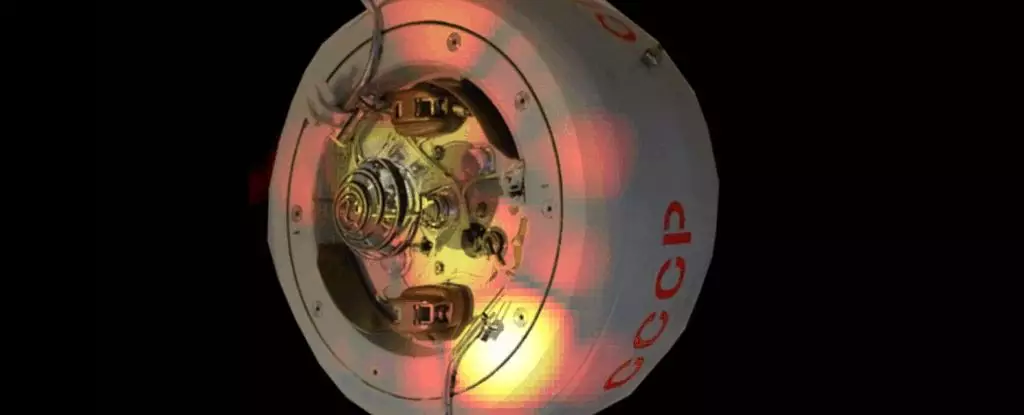The story of humanity’s exploration of the cosmos is punctuated by triumphs and tragedies, yet few tales resonate like that of the Soviet Venera program. Launched in the 1960s, the missions aimed squarely at Venus, our planetary neighbor shrouded in mystery and extreme conditions. With 29 probes launched over the years, only 16 managed to land or orbit Venus successfully. In comparison, many of the others remained hostage to Earth’s gravitational pull, reminding us of the profound challenges that space exploration entails. Among these probes was Kosmos 482, a relic of a bygone era that recently captured headlines as it completed its own bittersweet journey through the cosmos.
Launched in March 1972, Kosmos 482 was designed to descend upon the fiery environment of Venus, but fate had scripted a different narrative. For an astonishing 53 years, it remained in a sluggish orbit around Earth until its uncontrolled reentry on May 10, 2025, igniting both curiosity and concern within the scientific community and the public. The European Space Agency (ESA) provided insights into its reentry trajectory, indicating that while it sparked imaginations, it also highlighted the underlying issues surrounding space debris and our ever-expanding footprint in the heavens.
The Mystery of Kosmos 482’s Reentry
The descent of Kosmos 482 wasn’t merely a scientific curiosity; it served as a reminder of our current predicament regarding space junk. Images captured by the Fraunhofer Institute for High Frequency Physics and Radar Techniques painted a vivid moment in time—its tumbling descent was evidently chaotic, as the probe succumbed to Earth’s atmosphere after decades of floating forlornly in space. According to ESA, the precise location of reentry remains elusive, further emphasizing the uncertainties that still exist within the realm of space exploration.
As the probe passed over Germany on that fateful day, concern loomed about where debris would rain down. The best estimates suggested it plunged into the Indian Ocean, a fitting end for a vessel meant for a world enveloped in hellish conditions. Given Venus’s surface temperature of approximately 464 degrees Celsius and extreme atmospheric pressure, it is remarkable that Kosmos 482 was designed robustly enough to withstand such hostility, albeit never fulfilling its intended mission.
The Implications of Space Debris
The plight of Kosmos 482 brings to the forefront an urgent discussion about the mounting issue of space debris orbiting our planet. As more nations and private entities launch satellites and research missions, the problem has escalated dramatically. The concept of “Design for Demise”—crafted to ensure that objects in orbit are built to disintegrate upon reentry—has not been universally adopted, leading to concerns over potential catastrophic accidents.
While scientists and engineers strive to create fail-safe designs, a considerable amount of junk continues to encircle Earth. The lack of rigorous adherence to such design principles raises questions about our responsibility toward the cosmic environment. As we strive to unlock the mysteries of the universe, it becomes increasingly vital to ensure that our aspirations do not come at the expense of the fragile balance of our planet’s atmosphere and orbit.
The Dual Legacy of Space Exploration
Kosmos 482 stands as a poignant symbol of both ambition and negligence within the context of humanity’s explorative spirit. It encapsulates the quest for knowledge about our solar system while simultaneously highlighting the consequences of this relentless pursuit. Every glance at the stars should remind us that the universe is not an infinite resource; it must be treated with respect and caution. With technology advancing at a breakneck pace, we cannot afford to be complacent about the legacy of our spacefaring endeavors.
As memories of the probe’s initial vision fade, the challenges we face in understanding our place in the universe increase. Kosmos 482’s demise could serve as the catalyst for necessary changes in space mission designs, urging us to adopt best practices that prioritize safety—on Earth and beyond. Our adventures in the expanse of space should propel us into a future that is not just about reaching new heights, but also about safeguarding the celestial realms we have yet to fully discover.
In essence, the story of Kosmos 482 is not merely a historical footnote—it is an urgent call to action for future missions. As we look to the stars, let us also keep our eyes firmly grounded on the consequences of our flights into the cosmos, ensuring that our legacy is not marred by carelessness but enriched by sustainable practices. The cosmos may be vast, but so too should be our resolve to explore it responsibly.


Leave a Reply